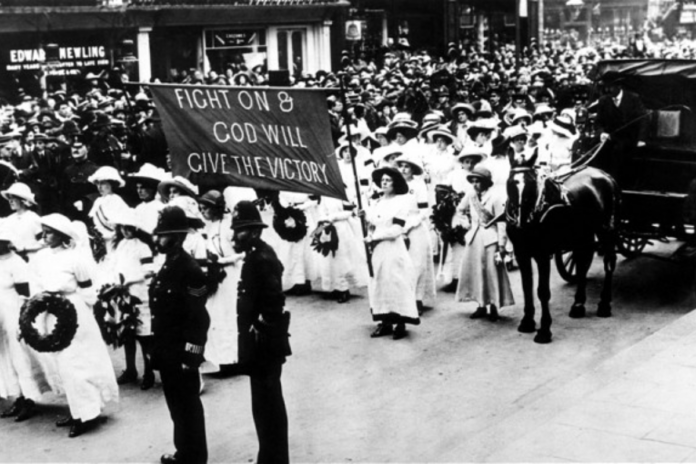A century after Emily Wilding Davison’s death at the Epsom Derby, the legacy of the Suffragettes endures, with contemporary feminists still employing the female body to challenge depoliticization.
Continuing The Legacy Of Suffragettes: Global Feminist Movements In The 21st Century
June 2013 commemorates the 100th anniversary of the death of British suffragette Emily Wilding Davison, who tragically lost her life at the Epsom Derby. Much like their predecessors in the early 20th century, women worldwide in the 21st century persist in uniting to advocate for equality.
In regions such as Pakistan and Saudi Arabia, efforts are underway to secure equal suffrage. Meanwhile, in India and across Africa, campaigns focus on securing equal rights, particularly in response to rampant sexual violence against women.
In Europe, activists like Pussy Riot members and FEMEN raise concerns about de-democratization, while movements like SlutWalk in the United States address issues of sexualized violence. These women carry on a tradition of public protest that echoes the fervor of early 20th-century Britain, where women fought for equal voting rights alongside men.
Also Read: Cultural Passions: Reading the Tarot
Emily Wilding Davison’s Legacy And Death: Recent Research Findings
Emily Wilding Davison’s actions catapulted her into fame as one of the most prominent suffragettes of her era. For a century, speculation swirled around her death, particularly regarding her possessions at the time. Many historians pointed to the return railway ticket found in her purse, suggesting she had no intention of committing suicide that day.
However, recent research by Elizabeth Crawford challenges this assumption, revealing that “special offer” return tickets were the only option available on Derby Day, thus undermining the significance of this piece of evidence.
Nevertheless, other recent studies into her death lean toward the belief that she did not intend to end her life but rather understood the potential consequences of her actions and was prepared to face them, whether it be arrest, injury, or even death. Much like FEMEN protesters a century later, Davison used her body as a form of protest.
Iconic Moments of the Suffragette Movement
Emily Wilding Davison’s death remains one of the most memorable events of the militant suffragette movement, captured on camera in the years leading up to World War I. During this period, thousands of women, alongside some men, engaged in the women’s suffrage campaign, resulting in hundreds of arrests as their demonstrations grew increasingly inventive.
For instance, the 1911 census boycott saw numerous women actively avoiding being recorded as “at home” by participating in activities like all-night roller-skating, midnight picnics in parks, and camping in caravans. Davison herself concealed herself in a broom cupboard within the House of Commons, listing it as her residence.
Frustrated by successive governments’ failure to advance the women’s suffrage agenda, the movement escalated towards militancy. Primarily, these actions targeted property, including setting fire to postboxes (for which Davison was imprisoned), smashing windows, and targeting symbols of patriarchy, such as cricket pavilions, in acts of protest.
State Response To Suffragette Militancy: Hunger Strikes And Force-Feeding
In response to the militant actions of suffragettes, the State opted for imprisonment rather than dialogue. The more radical suffragettes sought to be classified as First Division prisoners, a designation reserved for political prisoners rather than common criminals. Denied this status, they resorted to hunger strikes.
Marion Wallace Dunlop initiated this form of protest in July 1909, leading to her early release from prison. Subsequently, other suffragette prisoners adopted hunger strikes to demand recognition as political prisoners.
The State’s response to these hunger strikes was the brutal practice of force-feeding, aimed at exerting control and dominance over the incarcerated women. This method had severe and lasting health consequences for many, resulting in premature deaths. Hunger striking served as a protest against the classification of their imprisonment.
Fast forward a century, and we witness another group of women imprisoned for political reasons, namely the members of Pussy Riot, also resorting to hunger strikes.
Pussy Riot’s Protest And Repression: Framing Political Dissent As Religious Hatred
The Russian feminist punk band, Pussy Riot, gained widespread attention for their anti-Kremlin stance expressed through provocative song lyrics. In 2012, authorities arrested three members of the band – Maria Alyokhina, Nadezhda Tolokonnikova, and Yekaterina Samutsvich – after they performed one of their songs in Moscow’s Christ the Saviour cathedral.
Despite their political dissent, authorities charged them with ‘hooliganism motivated by religious hatred’. Tolokonnikova and Alyokhina were sent to prison colonies, while Samutsvich received a suspended sentence. Their brief protest targeted Vladimir Putin and his government’s close ties with the Russian Orthodox Church.
The State framed the charges as religious hatred, portraying the band members as religious dissenters rather than political activists, mirroring the tactics used against suffragettes in the early 20th century.
Alyokhina resorted to a hunger strike in May 2013, lasting 11 days, after being denied permission to attend her own parole hearing in her appeal to defer her prison sentence to care for her two-year-old son. Like the suffragettes before her, she employed the only means available – control over her own body – to protest against her treatment.
Continued Feminist Protests In Russia: Pussy Riot and FEMEN
The imprisonment of Pussy Riot members garnered significant support from prominent figures, including Madonna expressing solidarity during a concert in Moscow, and Paul McCartney and Yoko Ono using their celebrity status to appeal to Putin for leniency and early release for the women.
While the public widely recognizes Pussy Riot members as prominent feminist protesters in Russia, the FEMEN movement also maintains a significant presence. In contrast to the conservative femininity advocated by suffragettes in the early 20th century, FEMEN protesters often use nudity, such as during a protest aimed at Putin that resulted in an iconic image capturing his surprised reaction to a bare-chested protester.
Despite women’s ongoing collective political activism in the century since Emily Wilding Davison’s death, the response from the State, as observed in Russia, is to attempt depoliticization. Women’s bodily responses to such efforts can be seen as directly linked to the tactics employed by earlier suffragettes.
Also Read: Was fashion responsible for the outbreak of the First World War?


